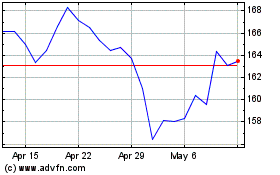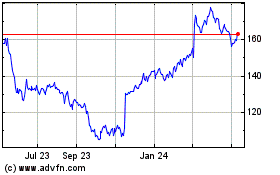Target Expands Plans to Remodel Existing Stores -- Update
20 October 2017 - 4:21AM
Dow Jones News
By Khadeeja Safdar
Target Corp. said it would expand plans to remodel its existing
supercenters and open smaller stores in cities as the retailer
seeks to win back shoppers in the competitive retail
environment.
At a media event Thursday, Target executives said they now plan
to remodel more than 1,000 of its 1,800 existing stores by the end
of 2020. Earlier this year, company executives said they planned to
remodel 600 stores over three years, part of a $7 billion
investment, including lowering prices and investing in
e-commerce.
Chief Executive Brian Cornell said he is making "big
commitments" to improving stores and expanding digital
capabilities. "We're remodeling and across the street someone is
closing the door," he said.
Mr. Cornell declined to say whether the new pace of remodels
would increase Target's spending plan, saying he would provide an
update at the next meeting with financial analysts. Sales have
increased 2% to 4% at recently renovated stores, he said.
The company has remodeled 110 stores so far in 2017. It is
opening 32 new stores in 2017 and 35 next year. Most of those new
locations are smaller formats that the company is opening in urban
areas and college towns. It is opening 11 such stores this week,
bringing the total number of smaller stores to 55 so far.
Mr. Cornell is trying to turn around the retail chain's fortunes
after it reported weak holiday sales last year and was forced to
lower its profit and sales goals for the current fiscal year. Some
of his moves, including lowering prices and remodeling stores,
helped the company report a sales increase in the third
quarter.
The smaller stores will help Target as it seeks to balance
shifting consumer habits, with more people shopping online. Mr.
Cornell said such locations have been twice as productive as the
company's traditional stores and have drawn new customers.
They typically have less than 50,000 square feet compared with
the average Target store of 145,000 square feet. To maximize shelf
space, Target stocks them with smaller package sizes and fewer
brands for many of the same items offered in bulk at its larger
stores.
Target is also customizing the assortment in the stores to cater
to local tastes -- the new location in New York City's Herald
Square, for example, sells city-themed clothes to appeal to
tourists visiting the area. It is opening across the street from
Macy's Inc.'s flagship store.
Mr. Cornell said the company is also focused on expanding
delivery options by using its stores as distribution centers.
Target plans to expand a new service across the country next year
that would let customers fill up a box of household essentials and
have it delivered the next day for a flat fee.
"The real battleground where we have to win is the last mile,"
said Mr. Cornell. "It's where we believe we can leverage our
stores."
Rival Wal-Mart Stores Inc. said recently it would open fewer
U.S. stores than it has in at least 25 years and deepen its
cost-cutting efforts to free up cash for e-commerce and store
improvements. Last week, Wal-Mart said it would only open about two
dozen U.S. stores next fiscal year, but the discounter has been
ahead of Target in remodeling its existing supercenters and ramping
up its web business.
Meanwhile, Amazon.com Inc. has been pushing deeper into physical
retailing. It acquired high-end grocery chain Whole Foods earlier
this year and has struck a partnership with department store chain
Kohl's Corp. that lets shoppers return Amazon goods at about 80
Kohl's locations.
Shares of Target, which have fallen 16% so far this year, rose
40 cents to $60.43 Thursday.
Write to Khadeeja Safdar at khadeeja.safdar@wsj.com
(END) Dow Jones Newswires
October 19, 2017 13:06 ET (17:06 GMT)
Copyright (c) 2017 Dow Jones & Company, Inc.
Target (NYSE:TGT)
Historical Stock Chart
From Mar 2024 to Apr 2024

Target (NYSE:TGT)
Historical Stock Chart
From Apr 2023 to Apr 2024
